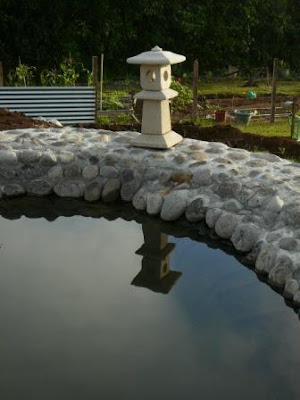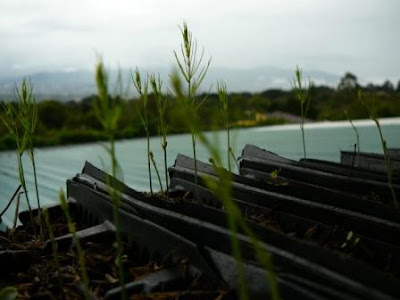It's been said that soil is the foundation of civilization. If society does not take care of its soil, it will eventually fail. This may or may not be an exaggeration, but it is definitely no exaggeration that soil is the foundation of any garden.
Clay, or better put, too much clay, can, at worst, be the downfall of your garden, or at best, make gardening much more difficult and challenging.
I have had some experience with clay. I gardened for 29 years in Clemson, South Carolina, an area made famous by a book written in 1942 by Ben Robertson. The title of Robertson’s book is
Red Hills and Cotton. By the phrase, red hills, Robertson was referring to, red clay. When the first European settlers began farming the northwestern corner of South Carolina in the latter half of 18th century, it was covered by a foot or more of rich, dark brown humus, which had been building up on the forest floor for thousands of years. For farming, it was like having money in the bank. But good soil, like a bank account, is something you must take care of, or you will eventually go broke.
Underneath the topsoil was hard, red clay. Unfortunately, due to the combination of hilly terrain and poor tilling practices, the topsoil slowly eroded away. By the 20th century the topsoil was gone, but the farmers continued to try to eke out an existence, in a place that now resembled more of a moonscape than a landscape. The arrival of the Great Depression in 1929, and the collapse of the demand for their crops (mostly cotton), was the last straw. Many farmers were wiped out, losing their farms to the banks, or selling them off for as little as a dollar an acre. These farmers were cursed by their forefathers, who, instead of improving the soil for a better tomorrow, farmed for short-term productivity, allowing the soil to slowly erode away.
Surprisingly, clay soils in general tend to be fairly high in plant nutrients. The problem is the structure and texture of the soil. Clay particles are extremely fine and flat. They fit tightly together, making it difficult, if not impossible, for plant roots to penetrate, and even if the roots do manage to grow, it allows little or no air to reach them. Plants breathe through their roots, and if they cannot do this, they die. When it rains, water fills what little air pockets there are in the clay, and the roots cannot breathe. During a dry spell, clayey soils maintain moisture longer than sandy soils, but when they do eventually dry out, they become as hard as rocks.
Sandy soils, on the other hand, are made up of larger particles, with a loose structure, and are easily penetrated by plant roots. In counterbalance, sandy soils tend to be lower in plant nutrients than clayey soils; they also dry out faster. What you want in your soil is a nice balance between clay and sand, and most importantly, you want lots of organic matter.
Quoting from
Home Vegetable Gardening, a publication of the Clemson University Extension Service, “Oftentimes gardeners get caught up in the beauty and bounty of the vegetables without remembering that the foundation for any healthy garden is soil. A good soil allows air, water and nutrients to be absorbed by plants’ root and lets those roots roam freely. How do you build healthy soil? Add organic matter.” Organic matter improves drainage in heavy clay soils. It holds the clay particles apart, improving air and water movement in the soil.
My garden in Clemson was located in an area that had once been a flood plain next to a creek. When our house was built in the 1960s, the builder covered the rich soil of the flood plain with a heavy clay loam. When I began gardening I added huge quantities of organic matter to it in the form of tree leaves, horse manure, and wood ashes. Within a couple of years I had a soft, rich loam. Plants thrived in it. I continued adding organic matter, and the garden just kept getting better and better.
When we purchased our lot in Costa Rica in 2006 it was covered with a silty, dark (almost black) volcanic soil. Unfortunately, this rich topsoil was only a foot or so thick. Underneath was hard red clay. During the excavation process for our house a lot of subsoil was dug up, and, unfortunately, bulldozed over the top of the topsoil. A couple of inches wouldn’t have been too bad, but the average depth of the clay is eight inches. If I were to start a brick factory, I would have been in business. As far as gardening, it was a catastrophe.
It was in April of 2009 that I got my first inkling of how bad the situation was. It was near the end of the dry season and I was going to dig up an area in preparation for planting some grass. I tried to drive a shovel into the soil. It was solid clay, and the shovel just bounced off. It didn’t matter how hard I banged on it with the shovel. It wouldn’t budge. The next day it rained. I tried with the shovel again, and this time the shovel went in, but it was almost impossible to get it back out -- it was a sticky mess. It was so sticky, in fact, I could not shake the clay off of the shovel, and had to use a knife to scrape it off. Breaking up sod is a hard enough job as it is, but breaking up heavy clay is next to impossible.
 |
| Clay on left; loam on right |
So, how does one tell if they have a heavy clay soil? Many clays are red; so a red color can be a good indication. But there are also yellow, gray, and even white clays. Take a fistful of soil in your hand and squeeze it as hard as you can. When you open your fist, if the soil maintains its shape exactly, you have a clay soil. If you then take it between your fingers and roll it, like you would with modeling clay, and it comes out ropey, you have a
heavy clay soil.
 |
| Both clay (on left) and loam (on right) have been squeezed. The clay maintained its shape. |
|
WHAT TO DO?
Okay. So, we know clay is a blessing for brick-makers, and catastrophe for gardeners. The question now is: What to do?
Plan A was to attack it piecemeal, and see what would happen. I bought two dump-truck-loads of topsoil, a couple of cubic meters of sand, and several bags of lime, and I began composting organic matter like mad. For my shrubs and trees, I dug large holes and filled them with my new homemade potting soil mix. It was the dry season, so I watered everything about twice a week. Things looked pretty good. When the rains began in mid-April (almost a month ahead of schedule) the plants really began to look quite good. Then on July 20th we got a four-inch rainfall in about three hours. Heavy rains continued several times a week after that. Soon I began to notice the plants were stressed. Leaves turned yellow and began to fall off and some of them began to wilt. What I had done was to make rainwater collection basins. The rain hit the clay soil, which it could not penetrate, so it ran downhill until it found the holes of good soil, where it collected, and rotted the roots of my plants.
About two weeks later I called my gardener in a panic and he and his helper came over and the three of us dug drainage ditches around everything. The plants began to recover, but then in August and September we averaged not quite an inch of rain a day. We shall see if anything prospers, or even survives.
Plan B is to scrape off the top of the soil with a backhoe, exposing the rich, organic soil underneath. But we will have to wait until the dry season for this, due to the difficult texture of the soil and the potential erosion and flooding that could result. And what will we do with all of that clay?
Today's blog has been a rant about clay. I apologize, but I had to get it off my chest, at least, for a while.
Happy gardening!








































